#melanosuchus
Text

Black Caiman (Melanosuchus niger), juvenile with Julia butterlfies, family Alligatoridae, Manu National Park, Peru
photograph by Walter Mancilla Huaman
803 notes
·
View notes
Photo






I’m a paleontologist, and my group of study are the crocodylians! They are so underrated and deserve more love! That is the reason why I love to draw them! Here are some crocs of Solimões Formation, the area I study :D
561 notes
·
View notes
Text
The Miocene Black caiman, Melanosuchus cf. niger
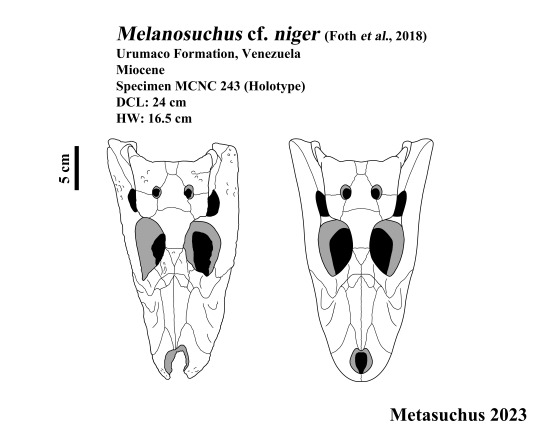
Here is a restoration of the skull of Melanosuchus cf. niger from the Miocene of South America. The holotype MCNC 243 along with a few specimens were described as Melanosuchusfisheri. MCZ 4336, the specimen on which diagnostic features of Melanosuchusfisheri were based on was reassigned to Globidentosuchusbrachyrostris.
It is possible that the holotype represents a sister species to the extant Black caiman ( Melanosuchus niger ) because of its Miocene origins but since no diagnostic features can be established due to its poor preservation, it was retained as Melanosuchus cf. niger.
References:
Bona et al., (2017). Shedding Light on the Taxonomic Diversity of the South American Miocene Caimans: The Status of Melanosuchus fisheri (Crocodylia, Alligatoroidea)
Foth et al., (2018). Cranial shape variation in jacarean caimanines (Crocodylia, Alligatoroidea) and its implications in the taxonomic status of extinct species: The case of Melanosuchus fisheri
#black caiman#melanosuchus niger#melanosuchus#caiman#croc#crocodilian#crocodilia#crocodylomorpha#pseudosuchia#fossil#paleontology#skeletal#miocene#venezuela#size comparison#paleoart
19 notes
·
View notes
Text
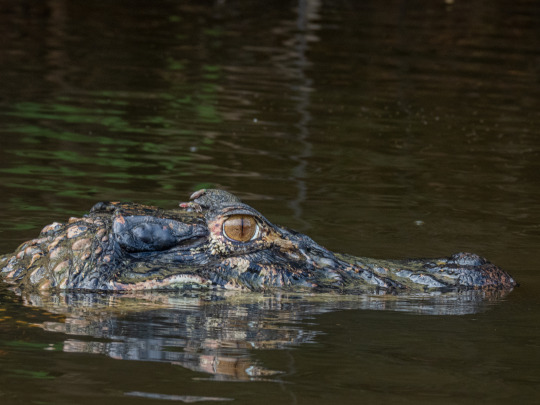
A black caiman (Melanosuchus niger).
Image courtesy of Jack Hernández.
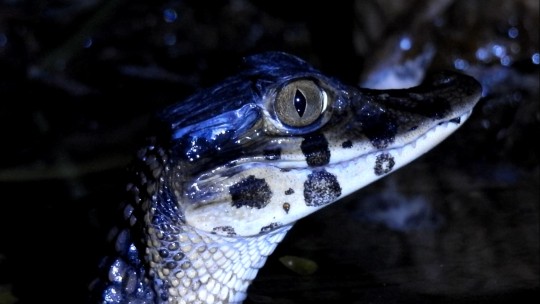
A newborn caiman.
9 notes
·
View notes
Text
A speculative arboreal crocodylian

A year ago I began my research on the Mekosuchians, especially around the genus Mekosuchus and my already very strong skepticism at that time about the claims that they were tree-dwelling crocodiles (Something extremely improbable and which I may comment on another occasion. For now you can read in depth about Mekosuchus in this post by Armin).
At that point I wondered ; what would an arboreal crocodile really look like if it existed?
I decided that it would be a derived member of the subfamily Caimaninae, specifically belonging to the Jacarea clade (which includes all species of the genus Caiman and Melanosuchus).
The body has evolved in a convergentely with squamates such as Varanus salvator, being thinner and more elongated than that of any other crocodylian, following the same process the tail : Once the motor that propelled it underwater, is now becoming something similar to a whip that allows it to maintain balance on the branches, losing the characteristic single and double caudal crest whorls, to the point of almost disappearing.
The dorsal osteoderms are shrinking, but are still visible and play an important role in the ecology of the animal, helping it to thermoregulate.
The limbs have been considerably widened and strengthened, an adaptation very visible in the metatarsals of the hind legs, which, together with the sharp, curved claws they have developed, help the animal to cling effectively to trees.
The skull is the most distinctive part of all, as it has not only become shorter and more robust as a whole (Males have even developed an anteorbital crest similar to that of some members of the genus Crocodylus such as C. acutus or the extinct C. checchiai ; very likely some kind of sexual dimorphism), but it is developing unique characteristics such as binocular vision, zyphodont dentition and laterodorsally positioned nostrils, all of these attributes usually associated with terrestrial hunters (although there is not a necessary relationship in all cases), thus moving away from the semi-aquatic lifestyle.
Despite this, these crocodiles are still dependent on water to a certain extent, always inhabiting the forests near the rivers and being able to swim perfectly well if necessary, just like the extant iguanas and monitor lizards.
If I had to add some kind of worldbuilding that allows the existence of this animal, it would probably be located millions of years in the future : After a cataclysmic event related to climate change, South America has suffered a process of desertification in which large bodies of water have dried up, forcing the very abundant babas (Caiman crocodilus) to move into the remaining forests and jungles, adapting to a more terrestrial lifestyle. As an isolated population of these caimans chose the birds and monkeys as their preferred prey, they would gradually follow them to the treetops.
After a few more million years, the land has recovered, and large rivers and lakes are once again flooding South America, favoring the emergence of large tropical jungles again, opening a new world for these tree-dwelling caimans. Will they manage to adapt to the new climatic conditions or will they become extinct as a consequence of this and other factors such as the emergence of new species of placental predators that threaten to occupy their niche? Well, that is uncertain.
The illustration was made in gouache and watercolors during September 2022 . I scupted a small-basic figure made in clay to in order to facilitate the understanding of the lights and shadows.
Here are some pictures of the process:

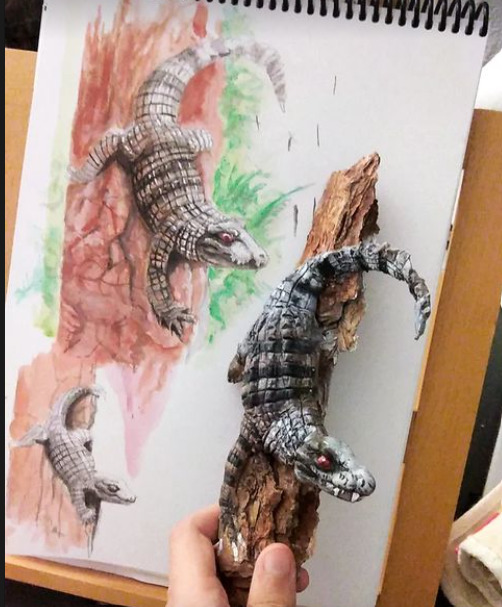
#animals#crocodiles#reptiles#zoology#crocodilians#paleoart#art#nature#speculative biology#speculative evolution#speculative zoology
230 notes
·
View notes
Text

Grzimek's Animal Life Encyclopedia. Volume 6: Reptiles. Written by Bernard Grzimek. 1984. Illustration by Helmut Diller.
1.) Dwarf caiman (Paleosuchus palpebrosus)
2.) Chinese alligator (Alligator sinensis)
3.) Spectacled caiman (Caiman crocodilus)
4.) Black caiman (Melanosuchus niger)
5.) American alligator (Alligator mississippiensis)
#reptiles#crocodilians#caimans#dwarf caimans#spectacled caimans#black caimans#alligators#chinese alligators#american alligators#Helmut Diller
335 notes
·
View notes
Text
12 notes
·
View notes
Text
ꕥ — WELCOME TO EXO COSMIA, LANGLEY. 🌑

ꕥ — OOC INFORMATION;
name / alias: Jessica
age: 26
pronouns: she / they
ooc contact: causalitymark on twitter
other characters in xc: Raven (Path to Nowhere), Mai Zenin (Jujutsu Kaisen), Sonetto (Reverse: 1999)
ꕥ — IC INFORMATION;
name: Langley
age: 42
pronouns: she / her
series: Path to Nowhere
canon point: Post-Chapter 13
app triggers: Assassinations, murder, war
personality:
A war criminal, a lapdog, a “cold-blooded Melanosuchus”... Langley has been called many names throughout her life, but the one trait that has managed to stick throughout them all is a fear of her. Known for her ruthlessness, Langley will see that a goal, or as is often the case, a target, is met with finality. To her, no cost is too steep for the right cause. Anything that stands in the way of her course is set to be removed.
On the other hand, those who have bonded with her will describe her as someone who ensures they are cared for. A kind person. In a world with perpetually winding turns, with psychic phenomenons overwhelming masses, catastrophes wiping out populations, and authorities who hold the sole pen over history, Langley provides a sense of safety to those taken under her wing. She finds no use in wasting the lives of good men and treats treats them as companions rather than pawns.
Beyond these two sides of her, Langley as an individual is cunning, devoted, humorous, loves to break the rules and leaves all the paperwork for her subordinates to fill out. She’s quite lazy.
something your muse struggles with: Flexibility. Langley is an extremist who is unwilling to stray from her path once she’s decided even if she’s walking towards her death.
your muse’s greatest strength: Loyalty, and a desire to see world change.
history / background:
Born in Paradeisos, a young and defiant Langley had quickly escaped its suffocating grasp by enlisting in the military. She soon rose towards the highest rank of the navy as an admiral with her own fleet to command. All of that would change when BR-003 broke out during the navigation observatory incident, awakening Langley as a Sinner. The first use of her newfound power was pointed towards the peace negotiator of the war at that time, whom she insisted on killing in spite of orders.
Records say that she had been court-martialed but no punishment had been established preceding her employment as the Head of the 9th Agency, an intelligence network working directly under Paradeisos. That is where the trail grows cold, and any other information related to her has been classified.
After Chief wipes out BR-004 and is detained for interrogations, Langley uses her authority to release them in exchange for delivering them to BR-001, the first and most potent of all recorded Black Rings. Before Chief delves in, Langley presses her gun against the back of their head and places a Causality Mark on them, stating that she gives them liberty to do as they please, that she pardons their secrets, but will ensure this bullet finds its way inside their head should they ever endager DisCity.
With that, Chief sets out to successfully wipe out BR-001, earning Langley’s approval. In that time, Langley had also made arrangements to place MBCC under the 9th Agency’s authority and now oversees Chief as their superior.
After a little more than a year passes, Langley herself is deployed within the re-awakened BR-002 to kill Parma, a target she had set her sights on for a long time. She turns her aim towards the rest of the Underground, meanwhile guiding her dearest subordinate, Chief, along their course among Paradeisos.
powers / abilities:
CONDITIONAL CAUSALITY: Langley is able to predict the conditions necessary to ensure her bullet hits any target marked with Causality. This, of course, may only be achieved if she fulfills all conditions.
inherent abilities:
SINNER: A Sinner carries superior physiology to the ordinary human, allowing them greater physical strength and faster regeneration of their body.
items / weapons:
PISTOL: It’s a shiny silver pistol that’s been customized to all hell to suit Langley’s tastes.
CANE: It’s a shiny silver cane with four snake ornaments coiled at the head, no of course it’s not a weapon, why would you think that? She’s an intelligence agent, not an assassin for goodness’s sake.
Here are the following features of her cane:
Darts coated in ricin. One of the ornaments acts as the trigger.
Knife. Slotted between the mechanism which shoots darts and the exterior, this is activated by pushing down on the head of the cane and retracts by pressing down on a surface that is greater than 5 on the Mohs Hardness scale.
Grappling hook. Also activated by a trigger, this sends the snakes sprawling into a four-pronged hook.
Mobility, for actual limping on her part.
starting ability: Conditional Causality
starting item: Cane
extra:
she is trans, and also so beautiful, and so scary, and my dream woman
i’m sorry there’s so much packed into the cane, i promise she rarely uses it for anything other than her messed up leg
discord id: 9thagency
0 notes
Text
0 notes
Text
Black Caiman
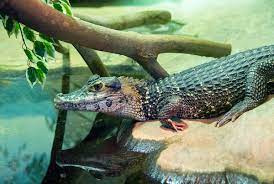
The black caiman (Melanosuchus Niger) is a crocodilian reptile endemic to South America. With a maximal length of 5 to 6 m and a mass of over 450 kg. it is the largest species of the family Alligatoridae and the third largest in the Neotropical realm by length.
0 notes
Photo

We forgot to post this! It's from the last year, but it's never too late, right? It's our tribute to the black caiman (Melanosuchus niger), maybe the biggest extant member of the family Alligatoridae. Illustration made with ballpoint pen and colored pencils.
This work is also available to purchase as print, posters, stickers and other cool stuff on Redbubble HERE.
★ Instagram|Patreon|Facebook|FurAffinity|RedBubble shop|Tapastic★
2 notes
·
View notes
Text
In an unexpected twist it turns out alligators can regrow their tails too
https://sciencespies.com/nature/in-an-unexpected-twist-it-turns-out-alligators-can-regrow-their-tails-too/
In an unexpected twist it turns out alligators can regrow their tails too
Cornered by a dangerous predator, a gecko can self-amputate its still twitching tail, creating a fleeting moment of distraction – a chance for the lizard to flee with its life.
Small reptiles such as geckos and skinks are well known for this remarkable ability to sacrifice and then rapidly regrow their tails. Now, to scientists’ surprise, it turns out that much larger alligators can regrow theirs too. But only while they’re young.
Juvenile American alligators (Alligator mississippiensis) can regrow up to 18 percent of their total body length back. This is about 23 cm or 9 inches of length.
What’s really cool is this regrowth appears to occur via a mechanism we’ve not seen before.
By imaging and dissecting the tail regrowth, researchers from Arizona State University (ASU) found alligators do this quite differently from the other animals we know that can regenerate their appendages.
Regrown tails are visibly identified by scale coloration, dense scale patterning, and lack of dorsal scutes. pic.twitter.com/adFdXs6rIY
— Cindy Xu (@xucindy) November 19, 2020
As far as regrowing body parts goes, amphibious axolotls are the champions of regeneration amongst land animals with internal skeletons.
If injured, they can reform a segmented skeleton, complete with muscles that differ along their height – distinguishing top from bottom.
Regrown lizard tails do not have a segmented skeleton, but lizards do reform muscles – although they look uniformly the same, with no variation in topside structure compared to the bottom.
This may be because regenerating appendages is physiologically expensive, and in smaller lizards has been shown to reduce overall growth rate.
Alligators, it seems, don’t even bother re-growing muscles at all.
“Clearly there is a high cost to producing new muscle,” said ASU animal physiologist Jeanne Wilson-Rawls.
The team believes that even a muscle-less extra bit of tail must give these dangerous predators an edge in their murkily watered homes.
Unlike lizards, they can’t self-amputate – their tail loss usually results from trauma inflicted by territorial aggression, or cannibalism from larger individuals.
Damage from human interactions, like motor blade damage have also been recorded.
The anatomical difference between original and regenerated tail. (Arizona State University)
The connective-tissue alligators replace skeletal muscle with is more like the wound repair you would see in the tuatara or in mammal wound healing, the team explains.
“The regrown alligator tail is supported by an unsegmented cartilage tube rather than bone… lacked skeletal muscle and featured scar-like connective tissue populated with nerves and blood vessels,” ASU cellular biologist and first author of the research Cindy Xu explained on Twitter.
“Regrown tails from juvenile American alligators exhibit features of both regeneration and wound repair.”
But regrowth of cartilage, blood vessels, nerves and scales is similar to what is seen in lizards.
“Future comparative studies will be important to understand why regenerative capacity is variable among different reptile and animal groups,” said Xu.
It also may take them considerably longer to regrow their missing bits. While skinks can do it in as little as six months, a related crocodilian, the black caiman (Melanosuchus niger) takes up to 18 months to reform their tails.
Alligators are an ancient lineage of reptiles, who shared a common ancestor with birds around 245 million years ago, back when non-avian dinosaurs dominated the Earth.
There’s fossil evidence of an ancient crocodilian from the Jurassic period that also had a regenerated tail.
This “raises the question of when during evolution this ability was lost. Are there fossils out there of dinosaurs, whose lineage led to modern birds, with regrown tails?” ASU biomedical scientist Kenro Kusumi questions.
“We haven’t found any evidence of that so far in the published literature.”
The team notes so far they’ve only been able to observe the end product of tail regenerations in alligators.
Given that they are a threatened species, further studies on how this process works may be challenging, but could provide some useful information.
“If we understand how different animals are able to repair and regenerate tissues, this knowledge can then be leveraged to develop medical therapies,” said ASU anatomist Rebecca Fisher.
This research was published in Scientific Reports.
#Nature
2 notes
·
View notes
Photo

Enquanto não consigo "aquela foto/vídeo" do "jacaré do açude do Poção", vão aqui algumas informações sobre as espécies de jacaré que ocorrem no Brasil. No Brasil temos seis espécies de jacarés. Ameaçados pela caça e perda de habitat, eles estão distribuídos em praticamente todo o país. Vamos conhecer todas as espécies, onde ocorrem e seus estado de conservação. Jacaré-açu (Melanosuchus niger) O maior jacaré do Brasil ocorre basicamente na Bacia Amazônica. Com os machos podendo chegar até os 6 metros de comprimento, são realmente gigantes. Hoje não se encontra como uma das espécies ameaçadas. Jacaré-do-pantanal (Caiman yacare) É um dos maiores alvos da caça por conta da pele e da carne. Hoje sua classificação está como Menos preocupante (LC) no risco de extinção. Jacaré-anão (Paleosuchus palpebrosus) É o menor Jacaré brasileiro, medindo até 1,5 metros. Animal que está distribuído por vários biomas Brasileiros e também por alguns países vizinhos. Jacaré-coroa (Paleosuchus trigonatus) Animal encontrado em grande parte da Bacia Amazônica. A espécie foi avaliada como Menos Preocupante (LC) na oficina preparatória para a elaboração lista nacional da fauna brasileira ameaçada de extinção em 2002. Jacaré-do-papo-amarelo (Caiman latirostris) O jacaré-de-papo-amarelo é o que apresenta a situação mais complexa no que tange a conservação, uma vez que sua área de distribuição geográfica coincide com as áreas mais densamente ocupadas no Brasil (Nordeste, Sudeste e Sul). Jacaré-tinga (Caiman crocodilus) Habita a região Norte, vivendo nas bacias dos rios Amazonas e Orinoco e, no Centro-Oeste, nas bacias dos rios Araguaia e Tocantins. Chegam medir 2 metros de comprimento. #biologia #biology #ciências #science #herpetologia #herpetology #natureza #répteis #reptile https://www.instagram.com/p/CJ7DxGGB4h7/?igshid=1lk43onlp07i7
0 notes
Photo

#Repost @luksth (@get_repost) ・・・ One day in the city and I'm already missing so much the jungle 😅 . This is a portrait of a Black Caiman (Melanosuchus niger) while floating in the Añangucocha lake, inside the Yasuni National Park. They can reach 6 m (20 ft) and, together with the Orinoco Crocodile, they are the largest reptiles in the Neotropics. . Caimans, together with Giant Otters, Harpy Eagles, Jaguars and Anacondas are the top predators in the Amazon Basin. They serve as keystone species, vital to this ecosystem. . . . . . #nature #wildlife #biodiversity #conservation #ecuador #amazon #tropics #yasuni #reptiles #herping #caiman @napowildlifecenter @ilcp_photographers
#repost#wildlife#yasuni#ecuador#caiman#herping#conservation#reptiles#tropics#biodiversity#amazon#nature
1 note
·
View note
Text
VÍDEO: Jacaré-açu é abatido a tiro e marretadas no rio Madeira em Porto Velho

Suspeitos de matarem o jacaré ainda não foram identificados. Caçar animal silvestre é crime e pode resultar em pena de seis meses a um ano. Jacaré-açu é morto a tiro e marretadas em Porto Velho.
Divulgação
O Batalhão da Polícia Ambiental (BPA) apura o caso de um jacaré-açu que foi abatido no rio Madeira, em Porto Velho, no início desta semana. Imagens recebidas pela polícia (veja vídeo abaixo) mostram o momento em que um suspeito atira no animal e outro o golpeia várias vezes na cabeça com uma marreta. Até o momento ninguém foi preso.
O caso ocorreu no último dia 7 de setembro. Após o recebimento das imagens, uma equipe da polícia foi ao local do abate, mas encontraram apenas a carcaça do animal. Uma marreta e uma faca foram apreendidas. O caso foi registrado na delegacia de crimes ambientais da cidade.
O capitão Jairo Carneiro, subcomandante do Batalhão da Polícia Ambiental, disse que há indícios de que o jacaré tenha sido abatido com tiro de arma de pressão. Depois da marretadas, os suspeitos teriam puxado o animal às margens do rio.
Nenhum dos suspeitos foram identificados até última atualização desta reportagem.
Jacaré-açu é abatido a tiro e marretadas em Porto Velho
Com base no artigo 29 da Lei 9.605, caçar animal silvestre é crime. Nesse caso, a multa para quem comete o abate pode chegar a R$ 5 mil, além de pena de seis meses a um ano.
O animal assassinado é um jacaré adulto da espécie Melanosuchus niger (jacaré-açu). Segundo o capitão Jairo, ele esteve à beira de extinção “por conta valor comercial do seu couro e da sua carne”.
A espécie é encontrada exclusivamente na bacia Amazônica, onde tem ampla distribuição. Também ocorre em sete países da América do Sul, sendo a maior parte em território brasileiro.
De acordo com o Instituto Brasileiro do Meio Ambiente e dos Recursos Naturais Renováveis (Ibama), essa é a maior espécie de jacaré. Com tamanho médio de 3,5 metros e mais de 300 kg, há registros de exemplares com mais de 5,5 metros.
“Também é conhecido como jacaré-negro. É um predador de topo de cadeia alimentar. Adultos de grandes dimensões podem predar qualquer animal de seu habitat, inclusive outros predadores de topo, como pumas, onças, jiboias e sucuris, se forem surpreendidos por esses répteis. Normalmente, se alimenta de pequenos animais, como tartarugas, peixes, capivaras e veados”, complementou Jairo Carneiro.
Artigo Via: G1. Globo
Via: Blog da Fefe
0 notes
Text
VÍDEO: Jacaré-açu é abatido a tiro e marretadas no rio Madeira em Porto Velho

Suspeitos de matarem o jacaré ainda não foram identificados. Caçar animal silvestre é crime e pode resultar em pena de seis meses a um ano. Jacaré-açu é morto a tiro e marretadas em Porto Velho. Divulgação O Batalhão da Polícia Ambiental (BPA) apura o caso de um jacaré-açu que foi abatido no rio Madeira, em Porto Velho, no início desta semana. Imagens recebidas pela polícia (veja vídeo abaixo) mostram o momento em que um suspeito atira no animal e outro o golpeia várias vezes na cabeça com uma marreta. Até o momento ninguém foi preso. O caso ocorreu no último dia 7 de setembro. Após o recebimento das imagens, uma equipe da polícia foi ao local do abate, mas encontraram apenas a carcaça do animal. Uma marreta e uma faca foram apreendidas. O caso foi registrado na delegacia de crimes ambientais da cidade. O capitão Jairo Carneiro, subcomandante do Batalhão da Polícia Ambiental, disse que há indícios de que o jacaré tenha sido abatido com tiro de arma de pressão. Depois da marretadas, os suspeitos teriam puxado o animal às margens do rio. Nenhum dos suspeitos foram identificados até última atualização desta reportagem. Jacaré-açu é abatido a tiro e marretadas em Porto Velho Com base no artigo 29 da Lei 9.605, caçar animal silvestre é crime. Nesse caso, a multa para quem comete o abate pode chegar a R$ 5 mil, além de pena de seis meses a um ano. O animal assassinado é um jacaré adulto da espécie Melanosuchus niger (jacaré-açu). Segundo o capitão Jairo, ele esteve à beira de extinção "por conta valor comercial do seu couro e da sua carne". A espécie é encontrada exclusivamente na bacia Amazônica, onde tem ampla distribuição. Também ocorre em sete países da América do Sul, sendo a maior parte em território brasileiro. De acordo com o Instituto Brasileiro do Meio Ambiente e dos Recursos Naturais Renováveis (Ibama), essa é a maior espécie de jacaré. Com tamanho médio de 3,5 metros e mais de 300 kg, há registros de exemplares com mais de 5,5 metros. "Também é conhecido como jacaré-negro. É um predador de topo de cadeia alimentar. Adultos de grandes dimensões podem predar qualquer animal de seu habitat, inclusive outros predadores de topo, como pumas, onças, jiboias e sucuris, se forem surpreendidos por esses répteis. Normalmente, se alimenta de pequenos animais, como tartarugas, peixes, capivaras e veados", complementou Jairo Carneiro.
Artigo originalmente publicado primeiro no G1.Globo
0 notes